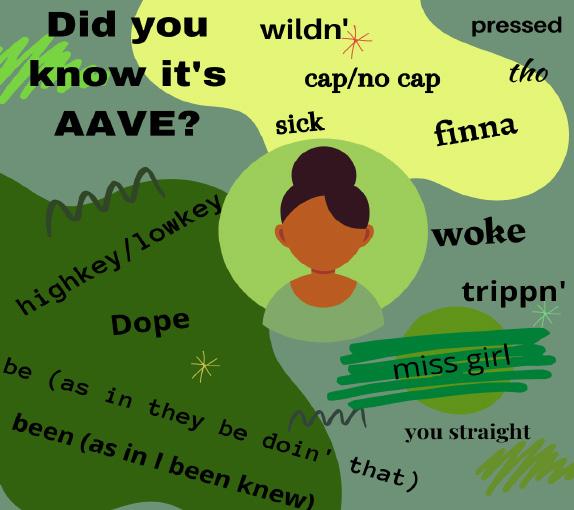
4 minute read
AAVE
Lovin’ a language
Misuse of language affects community
Advertisement
Katrell Readus readukat000@hsestudents.org
The use of Black inventions and cultural traditions by non-Black people has become something that is normalized and heavily accepted by the media today. However, this often leads to the perpetuation of stereotypes, turning culture into a commodity and using historical traditions as a trend. Despite this, the originating group continues to experience discrimination for engaging in their culture and traditions. To this, language is no exception. Within any culture, language is the basis for communicating ideas and plays a role in formulating a person’s sense of community and belonging. Yet, in pop culture, African American Vernacular English (AAVE) is often used by non-Black people for profit. In addition, AAVE is often used out of context in an attempt to be relevant, gain notoriety, attain acceptance or “relate” to Black people in social, academic and professional settings. AAVE is the dialect formerly known academically as Vernacular Black English and socially as Ebonics. While some features of AAVE are unique, this structure also shares many commonalities with other languages, including a number of standard and nonstandard English varieties spoken in the U.S. and the Caribbean. The stigmatization of AAVE can be traced to the issue of racism in the United States. It is often said that when people have a prejudice against a language system, it stems from unfamiliarity and lack of understanding. However, what they really have is a prejudice against people who are speaking it. This way of speech is looked down upon when used by the community it was created for, but celebrated when used by those in the white community. This social distinction wrongfully contributes to the perception of low intelligence or academic prowess in the Black community as a whole and its members who chose to use the language of their culture. The community has made strides to change the way it is viewed, but finding validation in the eyes of a society where their language, creations and contributions are always seen as subpar is a task that has continued to prove difficult. Despite the disrespect it is often met with, the grammar of AAVE is not “incorrect” or
“improper” at all; It simply has grammatical rules that differ from standardized English. This includes the use of double negatives found commonly in major languages like Spanish and French, as well as the habitual be. This particular rule places the word “be” as one that signifies a habit; the action it is referring to is done continuously by the sentence’s subject. AAVE is systematically rooted in history and provides an important identity marker and expressive resource for its Black users. However, the use of the vernacular outside of the community it was created by and for, is less stigmatized and even seen as “on-trend” and “cool.” This can be seen in modern-day and oldschool music as well as recent internet and social jargon. Similar to other things invented and/or popularized by the Black community, such as hairstyles, certain fashion looks and music, this vernacular continues to be considered
Graphic by Katrell Readus
disreputable until it is used by white celebrities, influencers or other notable figures. This has become a notion for pondering in recent years, especially after the rise of the Black Lives Matter movement as well as other movements and organizations fighting for better treatment of Black people. The vibrancy and authenticity of Black culture attracts people to it, but the problem lies in appropriation. Those who appropriate, dilute or completely alter the very qualities they claim to identify with or love, thus breaking the significance that Black cultural traditions hold. Non-Black people engaging in our culture often base their “understanding” of what they think Black culture is off of uninformed stereotypes typically portrayed by film and media industries. Examples of these stereotypes are unstable homes, poor manners, drug dependence and not being well-off financially. While many Black Americans are affected by these in a variety of ways, these things by no means depict the community as a whole. Those who believe these stereotypes associate these qualities, now established as essential to be edgy and cool, with Black cultural staples including long acrylic nails, bamboo earrings, oversized clothing, large or statement jewelry pieces and many other things popularized by Black culture. Using what the media now calls a “blaccent,” also known as a tone and language (AAVE) that is subconsciously or consciously connected with blackness, is another racially insensitive practice being used in an attempt to try on the attractive parts of blackness for attention and fame. The fact is, privileged people are reaching to be the embodiment of what they think Black culture is any time they are in search of a new edgy look or personality. Language is fluid, so there is not always an issue with white people using words popularized by Black culture that are now a part of accepted lexicon. However. know that the popularization of Black slang does not translate to the safety, acceptance and celebration of Black people.










